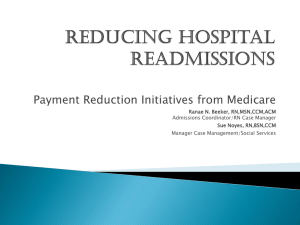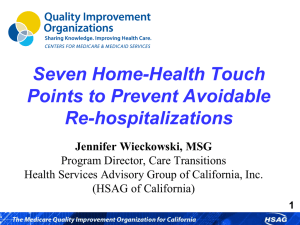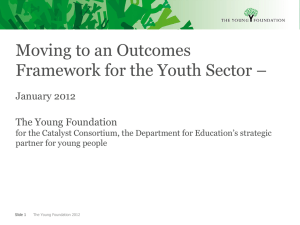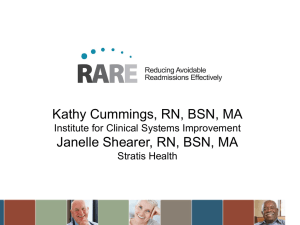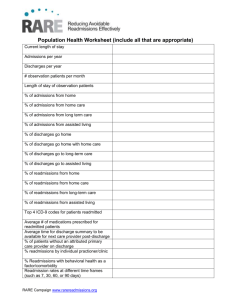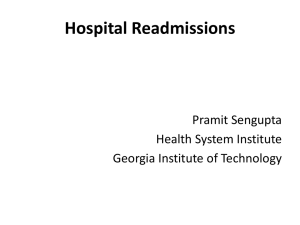090612 MedPAC Meetings summary
advertisement
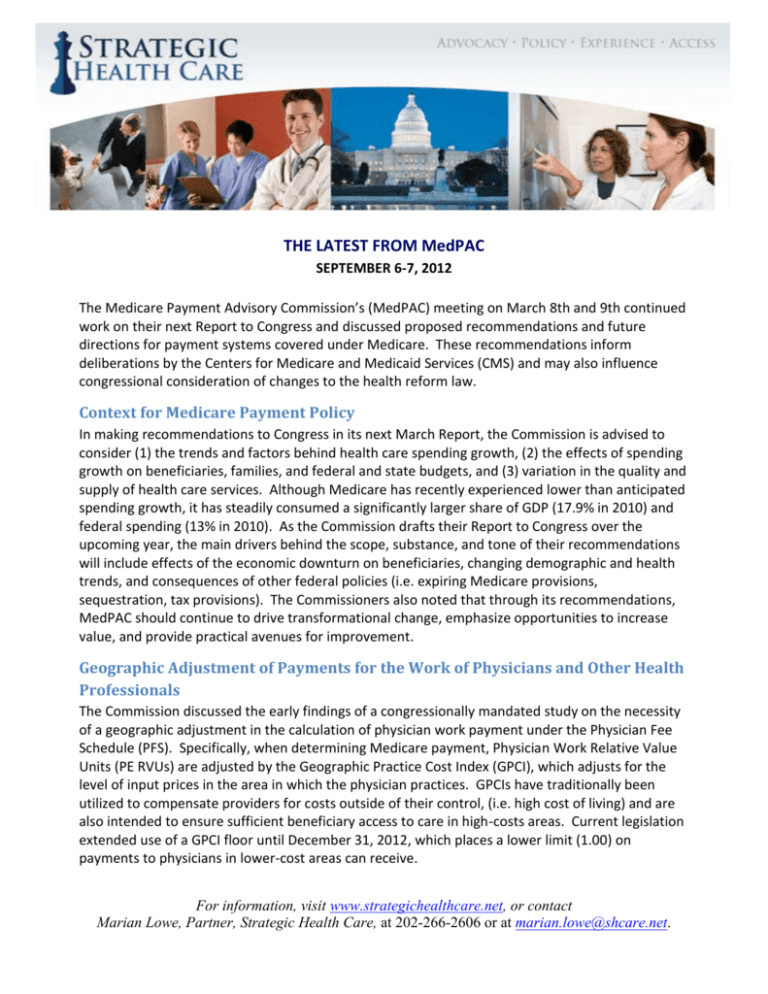
THE LATEST FROM MedPAC SEPTEMBER 6-7, 2012 The Medicare Payment Advisory Commission’s (MedPAC) meeting on March 8th and 9th continued work on their next Report to Congress and discussed proposed recommendations and future directions for payment systems covered under Medicare. These recommendations inform deliberations by the Centers for Medicare and Medicaid Services (CMS) and may also influence congressional consideration of changes to the health reform law. Context for Medicare Payment Policy In making recommendations to Congress in its next March Report, the Commission is advised to consider (1) the trends and factors behind health care spending growth, (2) the effects of spending growth on beneficiaries, families, and federal and state budgets, and (3) variation in the quality and supply of health care services. Although Medicare has recently experienced lower than anticipated spending growth, it has steadily consumed a significantly larger share of GDP (17.9% in 2010) and federal spending (13% in 2010). As the Commission drafts their Report to Congress over the upcoming year, the main drivers behind the scope, substance, and tone of their recommendations will include effects of the economic downturn on beneficiaries, changing demographic and health trends, and consequences of other federal policies (i.e. expiring Medicare provisions, sequestration, tax provisions). The Commissioners also noted that through its recommendations, MedPAC should continue to drive transformational change, emphasize opportunities to increase value, and provide practical avenues for improvement. Geographic Adjustment of Payments for the Work of Physicians and Other Health Professionals The Commission discussed the early findings of a congressionally mandated study on the necessity of a geographic adjustment in the calculation of physician work payment under the Physician Fee Schedule (PFS). Specifically, when determining Medicare payment, Physician Work Relative Value Units (PE RVUs) are adjusted by the Geographic Practice Cost Index (GPCI), which adjusts for the level of input prices in the area in which the physician practices. GPCIs have traditionally been utilized to compensate providers for costs outside of their control, (i.e. high cost of living) and are also intended to ensure sufficient beneficiary access to care in high-costs areas. Current legislation extended use of a GPCI floor until December 31, 2012, which places a lower limit (1.00) on payments to physicians in lower-cost areas can receive. For information, visit www.strategichealthcare.net, or contact Marian Lowe, Partner, Strategic Health Care, at 202-266-2606 or at marian.lowe@shcare.net. The mandated report will also consider arguments against a geographic adjustment, including that it may undercut competition in the national labor market, that it promotes unequal payment for equal levels of physician work, and that certain characteristics of rural practice with lower cost of living actually require higher levels of pay to attract physicians. Policy options suggested by MedPAC include eliminating the work GPCI entirely or retaining a ¼ work GPCI without the floor. The Commission also debated whether to move away from the GPCI and towards a simpler and more transparent cost of living adjustment for physician work. Medicare Payment for Ambulance Services MedPAC was also directed to report to the Congress on payment for ambulance services by June 15, 2013. The commission’s early discussion of the topic is intended to aide congressional consideration of extension of several add-on policies that expire at the end of 2012. There are three temporary payment policies covering ground rural and urban, ground super-rural, and air grandfathered urban locations that will expire at the end of the year. These temporary policies accounted for 7% of total ambulance payment (total spending is ~$6billion) in 2011. MedPAC staff also noted the unusual growth patterns in both basic life support (BLS) and dialysis transports as well as significant and unexplained variations in spending across states. The staff included summaries of literature on both ambulance cost analyses and HHS OIG findings of fraud and abuse. Finally, MedPAC staff offered policy options that could deal with the expiring temporary payment policies, the increase in dialysis transports, and increase in BLS nonemergency transports. The Commissioners did not appear to hold strong opinions on any policy options, although they did appear significantly concerned that growth in the number of dialysis transports was inappropriate. Approaches to Bundling Post-Acute Care Services Overall, bundling post-acute care (PAC) would fit into MedPAC's broad payment reform future outlook by improving payment and outcomes in the short-term while creating a foundation for long-term reforms and designs, such as ACOs. MedPAC staff addressed three design considerations for bundling PAC services: 1) making bundles out of PAC only or out of combined inpatient and PAC; 2) including or excluding readmissions; and 3) counting a long or short time period for the bundled services. For the first option, MedPAC staff argued that a combined hospital-PAC bundle would increase the incentive to coordinate care, but could also allow the consideration of payment to affect the decision to refer patients for PAC. For the second option, MedPAC staff believed that including readmissions in the bundle would again set up stronger incentives for coordinated care, but that the payment system would be terribly complex, since payment would need to be funneled to multiple providers and planned or unrelated readmissions should not be cause for financial penalty. For the third option, MedPAC staff noted that a shorter time period would cover services more related to the initial hospital stay, but the longer time period would include the most PAC services and would encourage more coordination of care. The Commissioners presented varying opinions on the PAC issues presented by MedPAC staff. Most Commissioners were in favor of the combined hospital-PAC bundle, but were mostly divided on the inclusion of readmissions and the length of time to be counted. Some Commissioners favored more inclusive bundles, while others favored more exclusive bundling, suggesting that bundles should be clinically based. Several Commissioners even proposed completely different policies, including paying for PAC on the basis of current data or creating different bundles at the individual and organizational levels. Other Commissioners criticized the proposals, stating that the For information, visit www.strategichealthcare.net, or contact Marian Lowe, Partner, Strategic Health Care, at 202-266-2606 or at marian.lowe@shcare.net. proposal would not include physicians in the relevant decisions, or would punish hospitals for treating sicker patients. Critical to this discussion will be whether the PAC bundling policies ‘go big’ in terms of a policy that would apply across all DRGs or are limited to a small range of DRGs such as the common services that are both high volume and high cost like cardiac and joint replacement services. Competitively-Determined Plan Contributions MedPAC staff introduced competitively-determined plan contributions (CPCs), a new topic debated by MedPAC. A CPC would include two parts used to buy Medicare coverage: competitively determined Federal contributions and individual premiums that would vary based on plan choice and the amount of Federal contribution. MedPAC staff described how Medicare Part D is an example of a CPC approach, where the coverage consists of a direct subsidy and a base premium. MedPAC staff then discussed CPC design issues, including whether to use a standardized benefit, and how to determine the Federal contribution amount. Finally, MedPAC staff covered several tangential issues, such as the role of FFS Medicare in CPCs, and how to deal with low-income beneficiaries. Since the topic was new to MedPAC, the Chairman asked the Commissioners to keep their comments brief. However, the Commissioners seemed a bit skeptical about CPCs, worrying about rebates, lack of mobility between plans, interactions with current plans, and evidence from Part D that shows patients might not take advantage of a range of choices. Improving Medicare's Payment System for Outpatient Therapy Services An exception policy allowing payments to outpatient therapy providers to rise above the congressionally mandated caps will expire at the end of 2012, and MedPAC is required to provide recommendations to the Congress on alternative policy options. Commissionsers and staff shared concerns about growth in spending without a cap in place, but also registered concerns that the current exception process is too automatic and involves almost no review by CMS contractors. MedPAC staff suggested several possible policy directions to improve the payment system. The first policy option would improve management of the therapy benefits in the short term by using new Secretarial powers to review possible fraud in high-use geographic areas, reducing the certification period from 90 to 45 days, and eliminating certain ICD-9 codes. The second policy option would collect information on functional status of patients over the long term using a standardized instrument, in order to report therapy needs to CMS and to move towards a bundled payment system. The third policy option would completely reform the payment system over the long term by designing an episode-based system or adopting a private sector approach (prior authorizations). The Commissioners appeared to be interested in preventing fraud, but did not seem as interested in completely revamping the entire payment system. One Commissioner seemed to speak for the room when she said that setting up a standardized instrument for data collection in the short room would be a good start, and perhaps the episodic payment system could come later. Refining the Hospital Readmissions Reduction Program MedPAC staff reviewed the PPACA hospital readmission reduction program that will take effect on October 3rd, using three specific conditions (AMI, heart failure, pneumonia) for now and adding at least four more conditions in 2015. Conditions with above average readmission rates based on Hospital Compare data for the specific conditions would receive a penalty applied to base operating payments and capped at 1% for 2013. The total penalties would sum to about 0.24% of For information, visit www.strategichealthcare.net, or contact Marian Lowe, Partner, Strategic Health Care, at 202-266-2606 or at marian.lowe@shcare.net. total inpatient payments in 2013, and 33% of hospitals would not be eligible to be penalized. MedPAC staff discussed several long term problems with the program that include calculation of the penalty amount, random variation, unrelated or planned readmissions, and socioeconomic status (SES) factors. The calculation of the penalty sets up counterintuitive incentives because the penalty increases as national readmission rates decrease. MedPAC proposed solutions that include using a fixed multiplier or switching to all-condition readmissions. Random variation can have a large affect on hospitals with a small number of cases. To increase the sample size, MedPAC proposed solutions that include switching to all-condition readmissions, using more years of data, or aggregating performance of hospitals in a larger system. Unrelated or planned readmissions can cause the readmission rates to rise because the current system does not allow for many exceptions. MedPAC staff proposed a switch to one of two other all-condition measures that would allow exceptions for unrelated and planned readmissions. Hospitals that serve patients with certain SES factors, such as low incomes, have higher than national average readmissions and could be punished for circumstances outside of their control. MedPAC proposed solutions that include adding SES factors to risk adjustment models, comparing similar hospitals when calculating the penalty, and providing more financial assistance to hospitals with high low-income shares of patients. Overall, the Commissioners supported the cause of reducing readmissions and were particularly concerned with the interaction between readmission and SES factors. However, most Commissioners seemed hesitant to commit to any of the staff's proposals, perhaps because adjusting the program would involve changing law, rather than regulation. Some Commissioners pointed to the fact that readmissions are currently in a decreasing trend and adopted an "if it's not broke, don't fix it" approach. Other Commissioners described further problems they envisioned with the entire program, such as the difficult and often opposite relationships between general admissions, readmissions, and mortality. Some Commissioners requested more data, while a small group of Commissioners suggested that the program should not be changed too hastily. Commission deliberations on the readmission program reforms will continue at subsequent meetings. The next MedPAC meeting is scheduled for October 4-5. For information, visit www.strategichealthcare.net, or contact Marian Lowe, Partner, Strategic Health Care, at 202-266-2606 or at marian.lowe@shcare.net.
